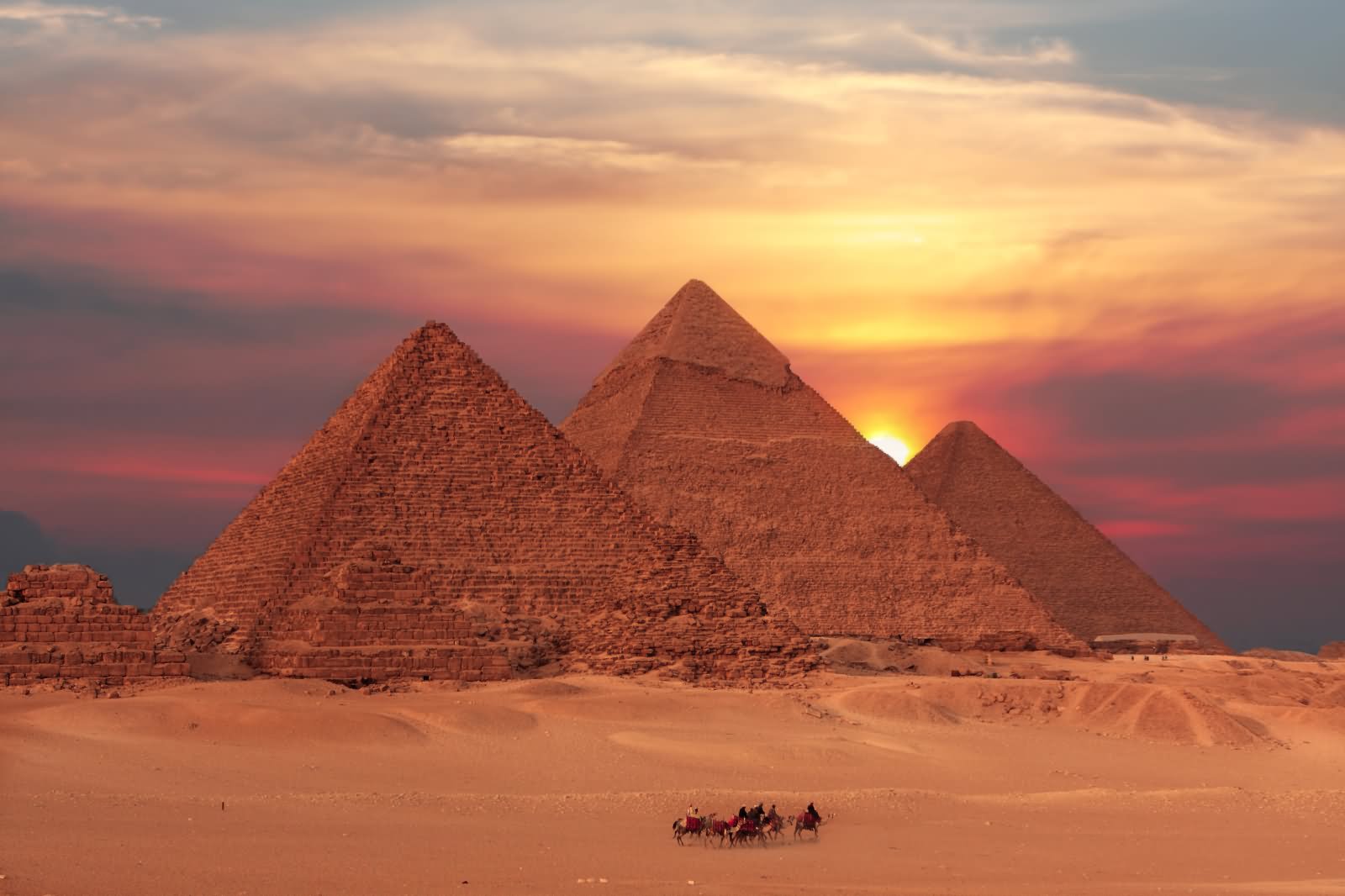Intricate Ancient Egypt
For almost thirty centuries, Egypt was the foremost nation in the ancient world. It's intellectual centers, advanced social structure and intricate religion have fascinated and inspired scholars from Aristotle to modern academics.
The famous pyramids embody Ancient Egyptian socio-political structure. The slope of the four sides rises to a single point, elevated above all - The Pharaoh. The idea that the Pharaoh was a semi divine figure that acted as mediator between the Gods and their people was key to maintaining the highly centralised government of Old Kingdom Egypt. The construction of the pyramids had no material benefit to the labourers, and a common misconception derived from this observation is that ordinary people, at the bottom of the pyramid, lived miserable lives pressed into building monuments and growing crops to feed the cities in return for just enough sustenance to stay alive. However, there is growing evidence that there was an independent local life too, including markets that sold produce and simple crafts.
 |
| The famous monuments enact Egyptian social higherachy |
Although the Pharaoh, at the top of the pyramid, was Egypt's religious and political leader, the everyday running of the state was undertaken by a vast, highly organised bureaucracy, which made up the next step of society's pyramid. The bureaucracy was made up of professional scribes, advisors, priests and local governors. Members of the bureaucracy enjoyed a much more comfortable life than the serfs that they ruled over. However, not all bureaucrats obtained their status from birth as the Pharaoh did, members of the lower classes showing sufficient skill, duty and loyalty often climbed the next step of the pyramid and became bureaucrats. The fact that anyone could, theoretically gain high office contradicts the popular despotic view of Ancient Egypt.
In addition to the serfdom enjoying greater opportunity, women of Ancient Egypt also had a means of climbing the pyramid, at least seven women made it to the summit and ruled the kingdom as a living Goddess. Ancient Egypt was not a feminist's paradise by modern standards; the government was male dominated and women's lives were often restricted to the household, but relative to other civilisations of the era, Egyptian women were treated very well. They were seen as equal in the eyes of the law; their rights included owning property, borrowing money and initiating divorce. By comparison, women in Ancient Babylonia were forced into marriages and were legally allowed to be raped by their husbands.
Furthermore, the intricate Ancient Egyptian religion is thought to have had a large influence on both modern and ancient cultures. Egyptian polytheistic religion was centred on interactions between the Gods, who were believed to be present in the forces of natures. Many elements of Egyptian religion were taken by other antiquital civilisations, for example worship of the Mother Goddess Isis became popular in Rome. Most significantly, the Egyptian polytheism was undoubtedly incorporated into Christianity. For example, the Egyptian holy trinity of Orisis-Isis-Horus, was definitely an influence on Christendom. This was Egypt's most influential holy trinity; essentially, you have a ruler Osiris, who is killed by his brother Set who seizes power. Isis, his wife, finds pieces of her dismembered husband and puts him together but lacks his phallic piece so she creates one - an obelisk. She impregnates herself and gives birth to a son on December 25, the traditional date of Jesus' birth. The son, Horus, slays Set and then visits his father in heaven, a possible root of Jesus' ascension, who blesses him so that Horus returns to earth as the saviour and next ruler. The most common Ancient Egyptian artwork is of Isis with the child Horus in her lap which resembles the Mary and Baby Jesus iconography.
The story is not exactly the same as the Biblical account, but there are numerous parallels between members of each trinity. Isis' conception of Horus was viewed as immaculate, and without sexual intercourse, making it comparable to Jesus being conceived by the Holy Spirit to a Virgin. Horus is viewed as the Son of Isis and Osiris; an incarnation of a God into a human form, meaning that he is often associated with pharaohs, who were believed to be descendants of Horus. An obvious parallel can be drawn to Jesus, who is viewed by christians to be the Son of god, fully God and fully human. Both figures are also linked to the sun, Horus took Ra's place as the solar deity, while Jesus' resurrection is often portrayed in terms of the rising and setting of the sun. The fact that much of the Bible itself was written in in Egypt during the Ptolemaic kingdom, means that the authors of the Bible were familiar with the Osiris - Isis - Horus trinity, and the correspondence between the two is not a coincidence.
The significance of the likely Egyptian influence on Christianity can not be understated, at the turn of the 21st century, 2.4 billion people were members of the faith shaped by Egyptian mythology. Wars have been fought for centuries, people have been killed and others have dedicated their lives over these beliefs, which did not only originate from Israel and from the Apostles in Europe, but from the pagans of Ancient Egypt.
 |
| Left to right: Horus-Orisis-Isis trinity, a possible root of Christianity? |
Egypt was an intellectual centre, its mathematics and medicine were renowned throughout the Ancient world. Although it included a degree of spells and a belief in the supernatural, much of Egypt's medicine came from an advanced understanding of the anatomy. Papyrus scrolls include names for organs, and the Edwin Smith Papyrus scrolls demonstrate that the Egyptians understood the link between the heart and pulse, and even had a vague idea of the cardiac system. In addition to anatomical comprehension, the Egyptians had a vast pharmacology. Not all of the eight hundred remedies within the Eber Papyrus were effective, a paste of dates, acacia and honey did not act as birth control for example. However, many treatments were effective and are still used today; an infusion of pomegranate root was used to treat a tape worm infection, the alkaloids contained in it paralysed the worms, and relinquished their hold.
Ancient Egyptian surgery was also ahead of its time, physicians could reset dislocated joints, mend broken bones and even wrap open wounds in bandages with antiseptic properties. Evidence of advanced surgical techniques is commonplace, in the necropolis of Thebes the earliest prosthetic devices in existence were discovered. A false toe found attached to a mummy dating from 950 to 710 BC featured holes to fasten the toe onto the foot. The toe shows significant signs of wear, and combined with the practical design suggests that the toe was designed to help amputees to walk, and was not a false body part for burial purposes. The effectivity of Egyptian medicine is exhibited by the fact that Imhotep, the architect of the step pyramid, and the earliest known physician in history was venerated as a god of healing centuries after his death.
 |
| Imhotep: the real God of healing |
The Ancient Egyptians also studied the stars in considerable detail. The earliest known astronomical device dating back to 5000BC, the Nabta Playa calendar circle, was an alignment of stones to chart the rises of certain stars, and the direction of summer solstice. By 3000BC, the Egyptians had an accurate 365 day calendar and were aware of the leap year. Knowledge of the stars was used to fix the dates of religious festivals, and to determine the hours of night. Astronomical knowledge was used practically; to position buildings, for example the Pyramids were carefully alined towards the North star and the Amun-Re was positioned on the rise of the midwinter sun, and also using the Rise of Sirius to predict the annual Nile floods. Egyptian astronomers knew of the planets Mercury, Venus, Mars, Saturn and Jupiter, they even noted the retrograde motion of Mars.
The influence of the world's first mega-civilisation on our modern world cannot be understated. The intricacy and advancement of this culture never ceases to amaze, especially as archeology continues to bring new wonders to light.
Comments
Post a Comment